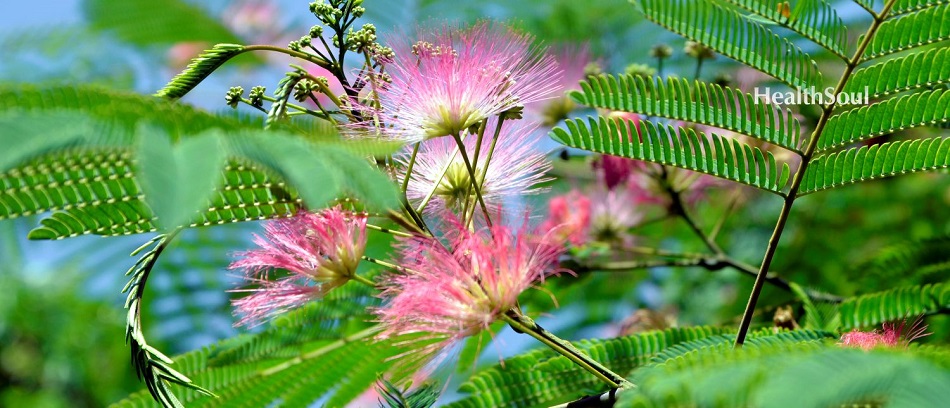
In Ayurveda, Mimosa pudica is a widely used herb commonly known as lajjalu. This herb is a perennial or annual creeper. The leaves of Mimosa pudica is touch and heat sensitive. The sensitivity of M. pudica leaves is controlled by the biological clock or depending upon the electrical and mechanical stimulation. The leaves of this herb is adapted the reopen closing response depending upon the electrical and mechanical stimulation. In English, this plant is commonly known as Touch Me Not due to its response of tough, and heat. [1] The whole plant, root, and leaves of this plant are used for medicinal purposes.
In the Ayurvedic medicinal system, this herb is used for its analgesic, antiasthmatic, antidepressant, and aphrodisiac properties. Throughout the tropical and subtropical parts of India and tropical America are the native place of Mimosa pudica.
Mimosa pudica leaves is a rich source of alkaloid. Mimosine is the primary alkaloid present in this herb. The leaf extract of Mimosa pudica contains alkaloids, coumarins, flavonoids, glycosides, phenols, quinines, saponins, tannins, and terpenoids. Some phytochemicals are also present in the roots of the plant, which include alkaloids, amino acids, fatty acids, flavonoids, glycoside, phytosterol, and tannins. However, depending upon the solvent used for the extraction process also alters the composition and concentration of phytochemicals present in Mimosa pudica. [1]

Health benefits of Mimosa pudica follows the different mode of actions due to presence of different phytochemicals in it.
Different ayurvedic formulations like Samangaadi Churna, Pusyanug Churna, Kutajavaleha, Bhret Gangadhara Churna are different powdered dosage form of Mimosa pudica. The recommended dose is 10–20 g of the drug for decoction. [1]

Our ancestors have already discovered sedative, emetic, and tonic properties of Mimosa pudica and traditionally this herb is used to treat insomnia, alopecia, urogenital infections, diarrhea, dysentery, and tumor. [1]

One of the reasons of the premature death of Indian villagers is due to poisoned from a snake bite. Naja naja (Asian cobra), and Bangarus caerulus (kraits) are very common snake in India. [3] Delay treatment often causes death. The antivenom effect of Mimosa pudica can inhibit phospholipase activity, fibrinolytic activity, hemorrhagic activity by neutralizing the venom obtain from snakebite. [2] Therefore, the antivenom activity of Mimosa pudica is an immediate and cost-effective treatment for Indian villagers. A proper dosage form can be used to treat for snakebite. The dried root extract of Mimosa pudica is recommended for its antivenom activity.
The leaf extract of this herb has anti-diabetic activity and lower down the plasma glucose level. [4]
Mimosa pudica root extract has anti-asthmatic effect. However, it has found that this herb is effective to stabilize mast cell and reduces histamine release. Thus it controls bronchospasm and also prevents an allergic asthma attack. [4]
In African traditional medicinal practice, Mimosa pudica is recommended to control seizure attacks. An animal research result also reported that Mimosa pudica leaf extract can control strychnine-induced seizures. [4]
Mimosa pudica stem extract is particularly used to accelerate wound healing mechanism. [4]
Mimosa pudica leaf extract has significant ulcer protective effect. Therefore, patients taking aspirin or other ulcer-triggering medicines can take this herb to prevent ulcer formation. [4]
Mimosa pudica has broad-spectrum antimicrobial properties, including antibacterial, antiviral and antifungal effect. The strong antibacterial property of Mimosa pudica has effective against Escherichia coli, Klebsiella pneumonia, Proteus vulgaris, Pseudomonas aeruginosa, Staphylococcus aureus, Salmonella typhi, Salmonella paratyphi A, Salmonella paratyphi B, Staphylococcus albus, and Shigella flexneri.
The anti-fungal property of Mimosa pudica is effective against Aspergillus fumigates and other similar class of fungal infection.
The antiviral property of Mimosa pudica may treat cholera due to its efficacy against Vibrio cholerae. [1]
Root extract of Mimosa pudica has showed promising treatment measure for uterine bleeding symptom. [1]
Root extract of Mimosa pudica can be used for family planning as it has antifertility effect. It extends the estrous cycle and restrict the gonadotropin hormone release. Administration of Mimosa pudica decreases FSH levels in the proestrous and estrous stages and ovulation disturbed. M. pudica root powder treatment for two weeks reduces the number of ova release and significantly increase the amount of degenerated ova. These findings are confirmed through animal research. [1]
Recently a research result reported M. pudica leaves has promising anxiolytic effect due to its agonistic effect on GABA/benzodiazepine receptor complex. The flavonoids present in this plant leaves structurally similar like diazepam. M. pudica leaves also act as an antagonistic effect on 5-HT1B receptors, or an agonistic activity on 5-HT1A receptors. [5]
Following are some widespread traditional application of M. pudica:
High dose of M. pudica can cause kidney and liver toxicity due to its high tannin content. Therefore dosage is an important consideration to safe use of this herbal remedy. [6]

During pregnancy and lactation avoid intake of Mimosa pudica due to lack of safety data and tannin content.
References
1. Mimosa pudica L. (Laajvanti): An overview.
2. Pharmacology and Traditional Uses of Mimosa pudica.
4. Pharmacological and biological overview on Mimosa pudica Linn.
5. Effects of Mimosa pudica L. leaves extract on anxiety, depression and memory.
6. Adverse Effects of Tannin Contained in Mimosa pudica Root Extract.
![]()